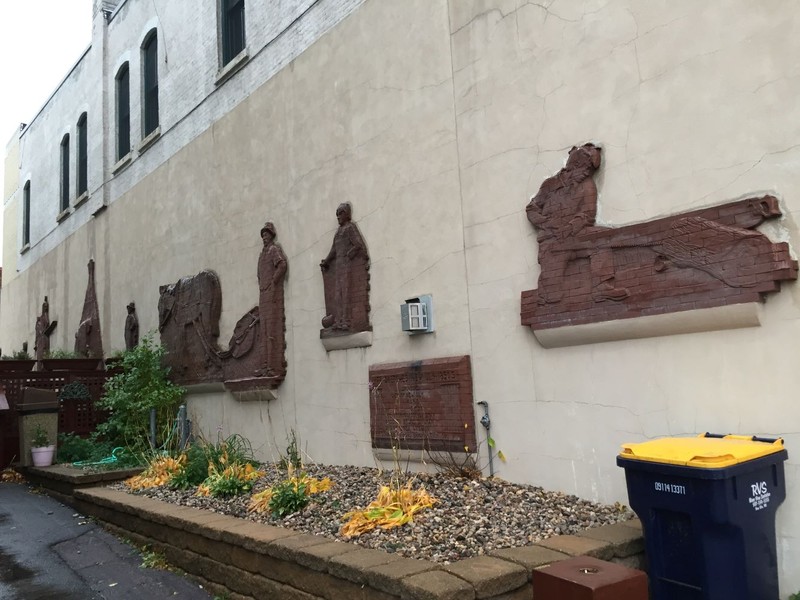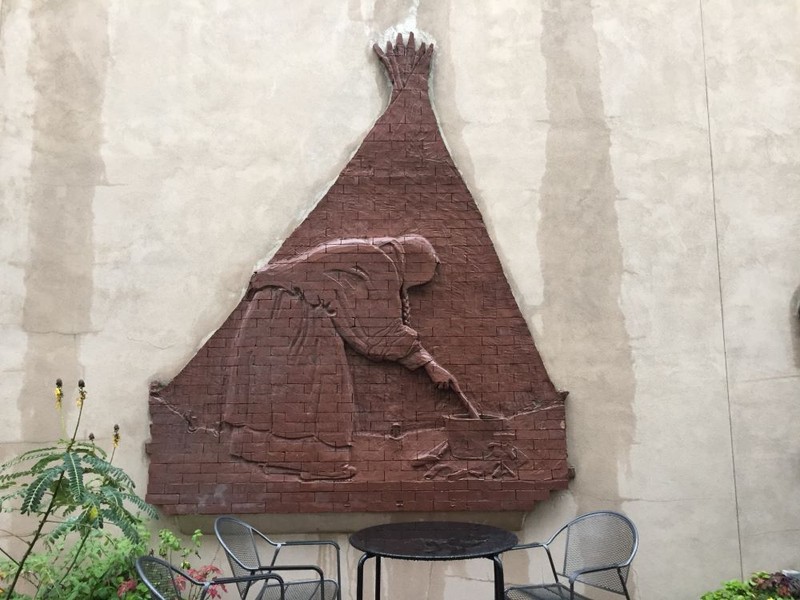Life Sketches Mural (1976)
Introduction
Text-to-speech Audio
This mural was created for the US Bicentennial in 1976. The New Ulm Business District and Southwest Minnesota State College commissioned artist Gordon Dingman to create a mural depicting frontier life in New Ulm. But Dingman's work was inspired by the 1973 violent showdown between Native American activists and federal officials at Wounded Knee, South Dakota. Dingman sought to depict peaceful coexistence between German immigrants, white American settlers, and Native peoples prior to the US-Dakota War of 1862 (widely known as the Great Sioux Uprising).
Images
Life Sketches mural overview

Life Sketches Native woman

Backstory and Context
Text-to-speech Audio
Artist Gordon Dingman sought to depict Indians and white settlers coexisting peacefully in the area prior to the 1862 US-Dakota War. His mural depicts four scenes of local settlements that incorporate both whites and Indians. In the first, white and Native women do domestic work on either side of a mounted Sioux warrior, suggesting parallels, if not meaningful cultural connections. But Dingman did not treat Indian and white male figures equally. In a second scene, three white laborers, a draft horse, and a drag symbolize westward expansion. Dingman intended his use of “direct frontal views and uncompromising postures [to] suggest national attitudes of that period leading to broken treaties, exploitation and ultimately war.” A third scene depicts an Indian man dressed in white-style clothing using the wrong end of a saw, suggesting that he was waiting for “another man/cultural group to help him transition into a changed world.”[1] Thus, while Dingman sought to stress peaceful coexistence, his mural instead shows the persistence of the assumption that settlers were more advanced while portraying Native peoples as backward.
New Ulm’s sculptural brick mural "Life Sketches" established local German immigrants’ connections to American settlement as progress by setting those immigrants against an image of Indigenous people that assumed backwardness. New Ulm’s 1974 mural also depicted relative interracial harmony that preceded a local armed racial conflict: the US-Dakota War of 1862 (more commonly known by the culturally-biased title the Great Sioux Uprising). Like many other Indian wars, the 1862 US-Dakota War was caused by decades of broken promises and encroachment by white settlers. White settlement on Native homelands destroyed traditional lifeways and resulted in Native Americans’ physical removal and cultural erasure. Fearing widespread starvation when the U.S. Civil War delayed a federal treaty payment, bands of Dakota (Sioux) warriors lashed out at local settlers, many of whom were recent immigrants from Germany and Scandinavia, killing more than 600 whites (many of them unarmed civilians) and devastating the German town of New Ulm. Local militias and the Union Army soundly defeated the Dakota warriors. Thirty-eight Dakota combatants were hanged in the largest mass execution in American history. The Dakota people--most of them noncombatants--were driven out of Minnesota and into internment camps and reservations in surrounding territories.
Having forcibly removed the Dakota from Minnesota, local whites joined Far Western cities in memorializing their racial superiority. In the 1890s New Ulm dedicated a state-sponsored monument honoring the whites--both immigrant and native-born--who had “defended” their settlement “against the savage Indians.” At the dedication of the obelisk mounted with battle scenes, Hon. John F. Maegher declared that the “defenders” “saved our state and its lovely women.”[1] Well into the 20th century, local whites commemorated white victims of what they called the Sioux uprising or massacre. They expressed little sympathy for the plight of the Dakota people while also erecting a monument to Dakota men who fought and killed members of the tribe.
That history of Indian removal came to the forefront when, in preparation for the 1976 national bicentennial celebration, the New Ulm Business District and Southwest Minnesota State College commissioned a mural depicting frontier life in the town. New Ulm had been settled by the socialist German-American Turner Society in the 1850s. In keeping with the town’s German cultural identity and standard American depictions of technology and progress, the Historic Trail committee envisioned a mural depicting beer wagons, trains, and a steamboat. As artist Gordon Dingman, who was born in New Ulm, began sculpting the relief mural, however, he became captivated by the 1973 violent showdown between American Indian activists seeking to reclaim indigenous lands and federal law enforcement at Wounded Knee, South Dakota.
By the early 1970s, indigenous rights activism such as that at Wounded Knee had persuaded some Minnesotans to reconsider the history of the Dakota War, recognizing that the conflict represented a desperate response to white conquest of native lands and mistreatment at the hands of the US government. Dingman sought to depict German settlers and Santee Sioux living in relative harmony on the Minnesota frontier prior to the 1862 war. His interpretation stopped well short of challenging the long-accepted narrative of American Indian savagery, however. Although Dingman completed archival research to inform his depiction of both immigrants and Native peoples, the artist’s design flattened out the German immigrants’ ethnic identity. And his depictions of Dakota people were modeled on Euro-American depictions of Native Americans by artists George Catlin, Seth Eastman and Karl Bodmer that were themselves informed as much by myth as historic reality.
While Gordon Dingman sought to celebrate peaceful coexistence, his New Ulm mural actually reinforced the logic of manifest destiny. Dingman intended his design to critique uncompromising “national attitudes of the period leading to broken treaties, exploitation and ultimately war,”[2] but he depicted westward expansion as the central narrative in local history. The final scene depicts a Dakota man dressed in Anglo-style clothing using the wrong end of a saw, waiting for “another man/cultural group to help him transition into a changed world.”[3] While Dingman’s mural certainly depicted the Dakota in a more humane manner than did the 1891 Defenders monument, it fell well short of the artist’s intent to depict “racial and cultural openness.” Rather than celebrating traditional indigenous culture and gender norms, its primary message was one of white dominance.
Sources
[1] “Dingman Brick Sculpture Vertical File.” Brown County Historical Society Archives. New Ulm, Minnesota.
[2] Gordon Dingman text for sculpture brochure,1974. “Dingman Brick Sculpture Vertical File.” Brown County Historical Society Archives. New Ulm, Minnesota.
[3] Braun, Cj Carmichael. Marking Time: An Illustrated Guide to Brown County’s Sites of Historical Interest. New Ulm, Minnesota: Brown County Historical Society, 2006. http://www.browncountyhistorymn.org/uploads/2/1/9/9/21990898/marking_time__current.pdf.
Carley, Kenneth. The Dakota War of 1862: Minnesota’s Other Civil War 2nd edition. St. Paul: Minnesota Historical Society Press, 2001.
Skarstein, Karl Jakob. The War with the Sioux: Norwegians against Indians 1862-1863. trans. Melissa Gjellstad and Danielle Mead Skjelver. Digital Press at The University of North Dakota, 2015.
“New Ulm’s Defenders”. Defenders Monument vertical file. Brown County Historical Society Archives. New Ulm, Minnesota.
“The U.S.-Dakota War of 1862.” accessed February 17, 2017, http://usdakotawar.org/.
Photo by Michael Lansing
Photo by Michael Lansing
